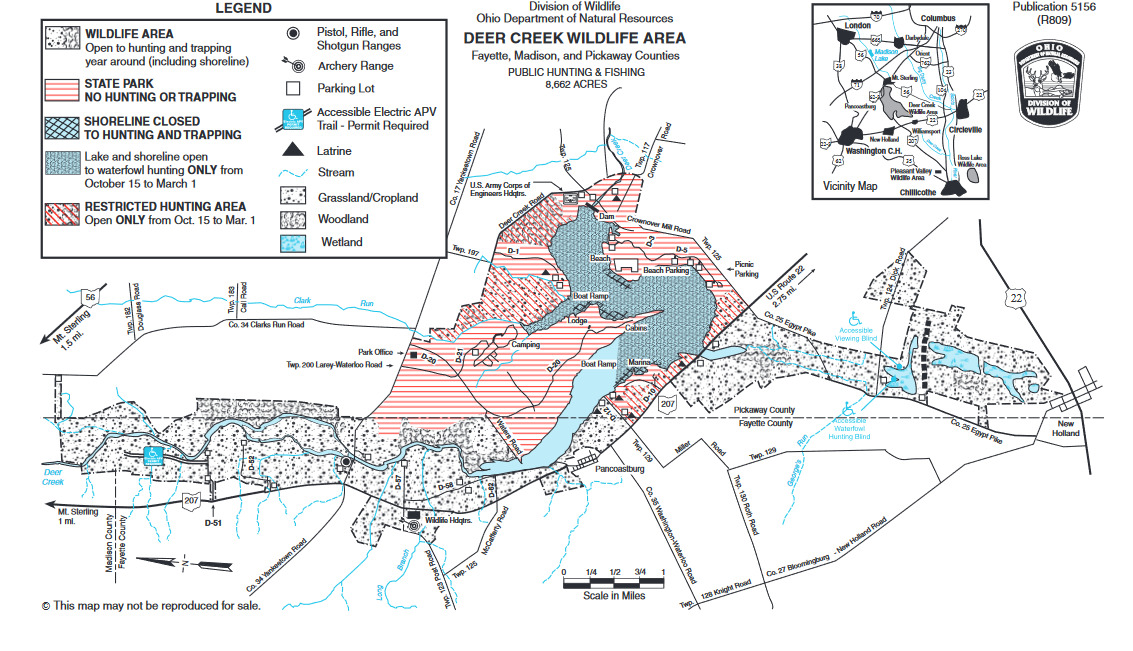Deer Creek Wildlife Area (Fayette Co.)
Deer Creek Wildlife Area (Fayette Co.)
Mount Sterling, Ohio 43143
Deer Creek Wildlife Area Official WebsiteDeer Creek Wildlife Area map
Deer Creek Lake webpage
Deer Creek State Park website
Also, see all the hotspots at:
Fayette County Birding Drive
Tips for Birding
The Fayette-Pickaway county line runs west to east through the wildlife area. On the west end, much of the wildlife area is south of the county line in Fayette County, on the east end, much of the wildlife area is north of the county line in Pickaway County. (See the map for the location of the county line.)
About Deer Creek Wildlife Area
See all hotspots at Deer Creek Wildlife Area
The 4,220-acre wildlife area is in central Ohio, four miles south of Mount Sterling on OH-207 and adjacent to the 1,277-acre Deer Creek Lake. It can be reached from the east and west by US-22 and OH-56, and from the north and south by US-62 and OH-3, OH-104, and OH-207.
The topography is flat to slightly rolling. The soils are mostly well drained and of medium to high productivity. Approximately 1,000 acres of row crops and small grains are under cultivation annually. Controlled burning and native warm season grass plantings have also been introduced as part of the wildlife management program.
About 25 percent of the wildlife area consists of second growth hardwoods and brush in advanced stages of succession. The timber stand is mainly on the east side of Deer Creek It includes oak, hickory, elm, black walnut, ash, maple, locust, sycamore, and cottonwood. Index of Ohio’s trees from the Division of Forestry. The uncropped remainder of the area is in permanent meadow, reverting fields, wildlife food plots, and prairie grasses.
Deer Creek Lake construction began in 1965 by the U.S. Army Corps of Engineers for flood control and was completed in 1968. Of the 7,575 acres, 6,875 are leased to the Ohio Department of Natural Resources for fish, wildlife, and general recreation purposes. Deer Creek State Park lies to the south and east of the lake and provides camping, picnicking, and boat launching facilities for the hunter and angler. Public hunting is permitted on some of the undeveloped 3,165 acres controlled by the Division of Parks and Recreation, and on all property controlled by the Division of Wildlife.
Wildlife management plans provide for the maintenance and protection of existing woodlands, establishment of field sizes and crop rotations beneficial to wildlife, improvement of open fields for wildlife nesting, and the establishment of annual food patches for general wildlife use. Permanent wildlife cover has been provided through the planting of native prairie grasses such as switchgrass, big blue stem, and Indiangrass.
Restrooms at Deer Creek State Park.
There is a handicapped accessible bird viewing blind at the Dick Road Wetland.
Content from Deer Creek Wildlife Area Official Website and Ohio Ornithological Society
